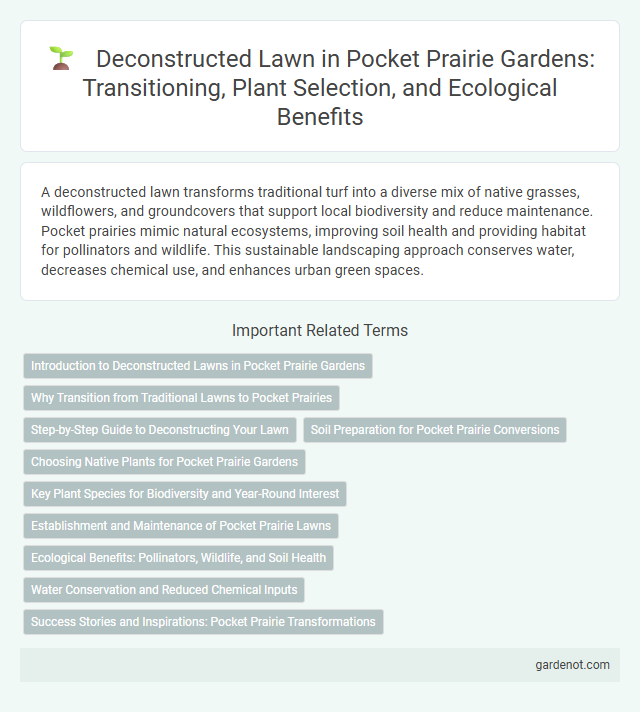A deconstructed lawn transforms traditional turf into a diverse mix of native grasses, wildflowers, and groundcovers that support local biodiversity and reduce maintenance. Pocket prairies mimic natural ecosystems, improving soil health and providing habitat for pollinators and wildlife. This sustainable landscaping approach conserves water, decreases chemical use, and enhances urban green spaces.
Introduction to Deconstructed Lawns in Pocket Prairie Gardens
Deconstructed lawns in pocket prairie gardens replace traditional turf with diverse native plants, enhancing biodiversity and reducing maintenance. These lawns incorporate native grasses, wildflowers, and pollinator-friendly species, creating resilient habitats that support local wildlife. By mimicking natural prairie ecosystems, deconstructed lawns improve soil health and water retention while offering aesthetic and environmental benefits.
Why Transition from Traditional Lawns to Pocket Prairies
Deconstructed lawns reduce water consumption by up to 50% compared to traditional turfgrass, significantly improving urban water efficiency. Incorporating native grasses and wildflowers in pocket prairies enhances biodiversity, providing essential habitats for pollinators and beneficial insects. Transitioning to pocket prairies also decreases reliance on chemical fertilizers and pesticides, promoting healthier soils and reducing environmental pollution.
Step-by-Step Guide to Deconstructing Your Lawn
Begin by assessing your current lawn's size, soil type, and sunlight exposure to plan the pocket prairie layout effectively. Remove existing grass using methods like solarization, sheet mulching, or manual sod removal, ensuring roots are fully extracted to prevent regrowth. Amend the soil with organic compost before planting native prairie species such as coneflowers, little bluestem, and black-eyed susans to establish a sustainable, low-maintenance ecosystem.
Soil Preparation for Pocket Prairie Conversions
Effective soil preparation is crucial for successful pocket prairie conversions by deconstructing traditional lawns. Begin with soil testing to determine pH and nutrient levels, then aerate compacted soil to enhance root penetration. Incorporate organic matter and native prairie seed mixes tailored to local ecosystems to promote biodiversity and sustainable soil health.
Choosing Native Plants for Pocket Prairie Gardens
Selecting native plants for pocket prairie gardens enhances soil health and supports local pollinators like bees and butterflies. Native grasses such as Little Bluestem (Schizachyrium scoparium) and wildflowers like Purple Coneflower (Echinacea purpurea) thrive in deconstructed lawns, requiring less water and maintenance. This approach fosters biodiversity while reducing reliance on chemical fertilizers and pesticides.
Key Plant Species for Biodiversity and Year-Round Interest
Key plant species for a deconstructed lawn in a pocket prairie include native wildflowers such as Echinacea purpurea, Asclepias tuberosa, and Monarda fistulosa, which provide habitat and nectar for pollinators. Incorporating grasses like Schizachyrium scoparium and Andropogon gerardii enhances structural diversity and supports soil health. These species ensure year-round ecological benefits by attracting diverse wildlife and maintaining visual interest through seasonal changes.
Establishment and Maintenance of Pocket Prairie Lawns
Deconstructed lawns in pocket prairies establish native grasses and wildflowers by incorporating site-specific seed mixes and minimal soil disturbance to promote biodiversity and resilience. Maintenance involves targeted mowing schedules, selective weed control, and seasonal monitoring to ensure proper growth and prevent invasive species dominance. Regular assessment of native plant health and adaptive management practices support a sustainable, low-input lawn ecosystem.
Ecological Benefits: Pollinators, Wildlife, and Soil Health
A deconstructed lawn transforms traditional turf into diverse native plant habitats that support pollinators such as bees, butterflies, and hummingbirds, enhancing biodiversity. This shift fosters wildlife by providing food and shelter for birds, small mammals, and beneficial insects while promoting a balanced ecosystem. The deep-rooted native plants improve soil health by increasing organic matter, enhancing water infiltration, and preventing erosion, which leads to a more resilient and sustainable landscape.
Water Conservation and Reduced Chemical Inputs
Deconstructed lawns in pocket prairies significantly enhance water conservation by replacing traditional turf grass with native drought-tolerant plants that require minimal irrigation. This shift reduces the need for frequent watering, promoting sustainable landscaping practices in regions prone to water scarcity. Furthermore, eliminating conventional lawn grasses lowers the dependency on chemical fertilizers and pesticides, resulting in healthier soil ecosystems and diminished environmental pollution.
Success Stories and Inspirations: Pocket Prairie Transformations
Pocket prairie transformations highlight successful deconstructed lawn projects that restore native biodiversity and reduce water consumption. Homeowners report flourishing native plant growth, increased pollinator activity, and reduced maintenance costs. These inspiring examples demonstrate how replacing traditional lawns with pocket prairies creates vibrant, sustainable green spaces that support local ecosystems.
Deconstructed lawn Infographic

 gardenot.com
gardenot.com